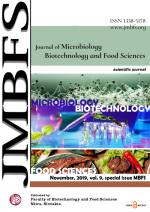THE PROFILE OF FATTY ACIDS IN CHICKEN’S MEAT AFTER HUMIC ACID AND PHYTOBIOTICS APPLICATION
DOI:
https://doi.org/10.15414/jmbfs.2019.9.special.439-444Keywords:
broiler chicken, fatty acid, humic acids, garlic, oreganoAbstract
The aim of the present study was analysed the effect of supplying humic acids separately and humic acids in combination with phytobiotic as garlic and oregano powder on fatty acid (FA) profile of the most valuble parts of Ross 308 chicken carcass. A total of 200 pcs Ross 308 broiler chickens of mixed sex were randomly divided into 4 groups (n=50): control group (C) without supplementation, experiment group E1 (2% humic acids), E2 (80% humic acids and 20% garlic powder) and E3 (90% humic acids and 10% oregano powder). Fattening period lasted for 42 days and all groups were kept under the same conditions. After slaughter, the FA profiles of breast and thigh samples were determined. In comparison with control group, FA composition of breast and thigh muscle, 7 out of 15 fatty acids was affected (P≤0.05) by dietary supplementation with humic acid (E1), combination of humic acid with garlic powder (E2) and combination of humic acid with oregano powder (E3). The most represented fatty acids in breast and thigh muscle in all experimental groups were oleic acid, palmitic acid and stearic acid. Comparing breast with thigh muscle, one unanticipated finding was that breast contained slightly higher amounts of total SFA (36.41 to 38.47% in breast vs. 32.63 to 34.20% in thigh). Besides, breast muscle was found to contain slightly lower proportion of total MUFA (49.01 to 50.27% in breast vs. 51.29 to 55.50% in thigh). Breast muscle had higher percentage of total PUFA (11.45 to 11.86% in breast vs. 7.49 to 9.87% in thigh). The results of the experiment confirmed that the addition of garlic and oregano powder in combination with humic acids can affect the fatty acid profile of chicken meat.Downloads
Download data is not yet available.
Downloads
Published
2019-11-08
How to Cite
HaÅ¡ÄÃk, P., Pavelková, A., Arpášová, H., ÄŒuboň, J., Bobko, M., TkáÄová, J., KaÄániová, M., & BuÄko, O. (2019). THE PROFILE OF FATTY ACIDS IN CHICKEN’S MEAT AFTER HUMIC ACID AND PHYTOBIOTICS APPLICATION. Journal of Microbiology, Biotechnology and Food Sciences, 9(Special issue), 439–444. https://doi.org/10.15414/jmbfs.2019.9.special.439-444
Issue
Section
Food Sciences
License
Copyright (c) 2022 Peter HaÅ¡ÄÃk, Adriana Pavelková, Henrieta Arpášová, Juraj ÄŒuboň, Marek Bobko, Jana TkáÄová, Miroslava KaÄániová, Ondrej BuÄko

This work is licensed under a Creative Commons Attribution 4.0 International License.
All papers published in the Journal of Microbiology, Biotechnology and Food Sciences are published under a CC-BY licence (CC-BY 4.0). Published materials can be shared (copy and redistribute the material in any medium or format) and adapted (remix, transform, and build upon the material for any purpose, even commercially) with specifying the author(s).





